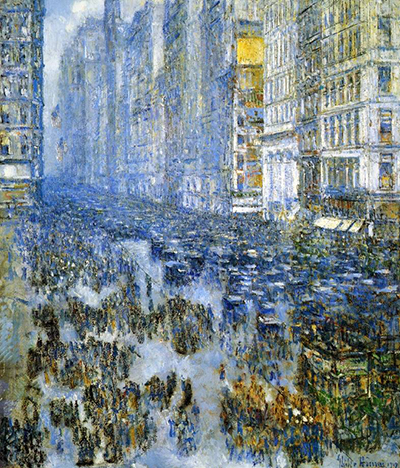One cannot help but see the work of Camille Pissarro when we browse Childe Hassam's Fifth Avenue. Comparisons with the likes of The Boulevard Montmartre at Night and Le Boulevard de Montmartre, Matinée de Printemps are inevitable.
Fifth Avenue is a painting from 1919 which is owned today by The Cleveland Museum of Art in the US. We find an exciting array of activity within this Childe Hassam painting, perfectly capturing the true essence of this famous US location. There is an endless number of figures dotted about on the left hand side of the work, none of which have large amounts of detail, but just enough to create the impression of what is going on. To the right hand side of the road, we find an even more compact route, with small vehicles vying for room. The tall buildings then reach up into the sky, marking out the dramatic nature of this street and the sprawling, vibrant activity found right across the city at that time. The particular colours used, as well as the less refined detail is entirely typical of the Impressionist movement and Hassam was an important part of a group of Americans who brought these ideas across to the US. They would eventually convince the public as to the qualities of this new style, but it would take some time before they started to sell their work with ease.
Childe Hassam would regularly feature views such as this within his paintings, and covered cityscapes more generally right across his career. This type of viewpoint, with tall buildings down one hand side, appealed to his taste in composition and had already featured many times in French Impressionism already. In other examples by Hassam, he would capture these same buildings whilst they were decorated in flags, giving titles such as The Avenue in the Rain and Allies Day, May 1917. As much as he loved city life, though, Hassam would have to retreat to the countryside fairly regularly in order to reconnect with nature and that brought about the other major body of work which form a large proportion of his oeuvre. Another common aspect found within Impressionism was to cover the same element under different conditions, be it lighting, weather or anything else. Hassam would create night and day scenes, as well as during periods of rain too.
Impressionism involved a strong use of blurred lines and this was entirely suitable to busy cityscapes such as this, where it could suggest movement between the many figures and vehicles. He may have noticed even then about how life was starting to speed up, leading towards the point today where most major city centres are on the verge of overcrowding, with some already having become overpopulated to most people's judgement. The 20th century marked a major development in city life, with more and more people flocking to them from rural areas, in search of work. There would also be great commercialisation and eventually cities such as New York would become fit to burst. Hassam loved this business, and found great inspiration for his work but avoided becoming trapped in these environments for too long.




